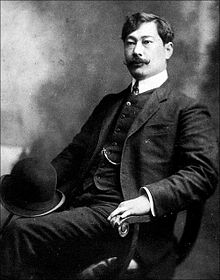Fujishima Takeji
Fujishima Takeji ( Japanese 藤 島 武 二 ; born September 18, 1867 in Kagoshima ; † March 19, 1943 in Tokyo ) was a Japanese painter who used elements of modern European painting, especially Impressionism , primarily for his pictures in modern Japanese Nihonga has become known.
biography
Fujishima Takeji studied Nihonga, modern Japanese painting, and moved to Tokyo in 1884, where he was accepted as a student of the Shijō teacher Kawabata Gyokushō . Around 1890 he switched to Yōga , painting in the western style, and studied here with Soyama Yukihiko and Yamamoto Hōsui . In 1896 Yōga was taken as a course at the Tōkyō Bijutsu Gakkō ( Tokyo School of Fine Arts ), today's Tōkyō Geijutsu Daigaku , and Fujishima became an assistant professor under Kuroda Seiki . At the same time he also became a member of the Hakubakai artists' associationaround Kuroda, the "White Horse Society". Through Kuroda he came to impressionism and plein air painting, at the same time he was strongly influenced by Art Nouveau and the styles of fin de siècle .
From 1890 Fujishima painted cover illustrations for the magazine Myōjō , in German "Morgenstern". He became better known through oil paintings such as In Praise of the Tempyō Era in 1902 and Butterflies in 1906. In these pictures he combined the European styles with the Japanese Nihonga. In his later works he also tried to maintain this connection by simplifying the elements of nature.
From 1905 to 1909, Fujishima traveled to Europe with permission and a grant from the Japanese Ministry of Education to study in Paris and Rome. Here he met Fernand Cormon and Emile Auguste Carolus-Duran , with whom he worked and studied. In 1908/09 he created one of his most famous pictures, the Impressionist picture Black Fan , in the same year he painted the pond, Villa d'Este . Years later, in 1926, he also combined the European Renaissance painting, which he got to know on this trip, with the Asian one and painted Orchid , the portrait of a woman in a Chinese dress.
After returning to Japan, Fujishima became a professor at the Tokyo School of Fine Arts, where he took care of both the students and the professional organization of exhibitions. In the 1930s, the Surging Waves at Daio Point in 1932 and Terrassenfelder in 1938 were created with Japanese landscape motifs and clear, broad brushstrokes .
In 1937 he was one of the first artists to be awarded the newly awarded cultural order .
Image selection
- In Praise of the Tempyō Era. 1902; Ishibashi Art Museum in Kurume
- Butterflies 1906; Private collection
- Yacht 1908; Tokyo School of Fine Arts
- Black fan 1908/1909; Artizon Museum , Tokyo
- Weiher, Villa d'Este 1908/1909; Tokyo School of Fine Arts
- Orchid 1926; Private collection
- Surging Waves at Daio Point 1932; Eisei Bunko, Tokyo
- Terrace fields 1938; Ōhara Art Museum , Kurashiki
Remarks
- ↑ This picture was shown at the exhibition Japanese Painting in Western Style 1985 in the Museum for East Asian Art in Cologne.
literature
- Toru Asano: Fujishima Takeji.
- Japan Foundation (Ed.): Japanese Painting in the Western Style, 19th and 20th Centuries. Exhibition catalog, Cologne, 1985.
Web links
- Prints by Fujishima Takeji and other Japanese painters of the Meiji period in the Boston Museum of Fine Arts
- Fujishima Takeji Beach (with biography)
| personal data | |
|---|---|
| SURNAME | Fujishima, Takeji |
| ALTERNATIVE NAMES | 藤 島 武 二 (Japanese) |
| BRIEF DESCRIPTION | Japanese painter |
| DATE OF BIRTH | September 18, 1867 |
| PLACE OF BIRTH | Kagoshima |
| DATE OF DEATH | March 19, 1943 |
| Place of death | Tokyo |


